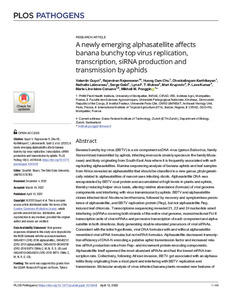| dc.contributor.author | Guyot, V. |
| dc.contributor.author | Rajeswaran, R. |
| dc.contributor.author | Chu, H.C. |
| dc.contributor.author | Karthikeyan, C. |
| dc.contributor.author | Laboureau, N. |
| dc.contributor.author | Galzi, S. |
| dc.contributor.author | Mukwa, L. |
| dc.contributor.author | Krupovic, M. |
| dc.contributor.author | Kumar, P.L. |
| dc.contributor.author | Iskra-Caruana, M.L. |
| dc.contributor.author | Pooggin, M. |
| dc.date.accessioned | 2022-05-20T15:14:11Z |
| dc.date.available | 2022-05-20T15:14:11Z |
| dc.date.issued | 2022 |
| dc.identifier.citation | Guyot, V., Rajeswaran, R., Chu, H.C., Karthikeyan, C., Laboureau, N., Galzi, S., ... & Pooggin, M. (2022). A newly emerging alphasatellite affects banana bunchy top virus replication, transcription, siRNA production and transmission by aphids. PLoS Pathogens, 18(4), 1-40. |
| dc.identifier.issn | 1553-7366 |
| dc.identifier.uri | https://hdl.handle.net/20.500.12478/7472 |
| dc.description.abstract | Banana bunchy top virus (BBTV) is a six-component ssDNA virus (genus Babuvirus, family Nanoviridae) transmitted by aphids, infecting monocots (mainly species in the family Musaceae) and likely originating from South-East Asia where it is frequently associated with self-replicating alphasatellites. Illumina sequencing analysis of banana aphids and leaf samples from Africa revealed an alphasatellite that should be classified in a new genus, phylogenetically related to alphasatellites of nanoviruses infecting dicots. Alphasatellite DNA was encapsidated by BBTV coat protein and accumulated at high levels in plants and aphids, thereby reducing helper virus loads, altering relative abundance (formula) of viral genome components and interfering with virus transmission by aphids. BBTV and alphasatellite clones infected dicot Nicotiana benthamiana, followed by recovery and symptomless persistence of alphasatellite, and BBTV replication protein (Rep), but not alphasatellite Rep, induced leaf chlorosis. Transcriptome sequencing revealed 21, 22 and 24 nucleotide small interfering (si)RNAs covering both strands of the entire viral genome, monodirectional Pol II transcription units of viral mRNAs and pervasive transcription of each component and alphasatellite in both directions, likely generating double-stranded precursors of viral siRNAs. Consistent with the latter hypothesis, viral DNA formulas with and without alphasatellite resembled viral siRNA formulas but not mRNA formulas. Alphasatellite decreased transcription efficiency of DNA-N encoding a putative aphid transmission factor and increased relative siRNA production rates from Rep- and movement protein-encoding components. Alphasatellite itself spawned the most abundant siRNAs and had the lowest mRNA transcription rate. Collectively, following African invasion, BBTV got associated with an alphasatellite likely originating from a dicot plant and interfering with BBTV replication and transmission. Molecular analysis of virus-infected banana plants revealed new features of viral DNA transcription and siRNA biogenesis, both affected by alphasatellite. Costs and benefits of alphasatellite association with helper viruses are discussed. |
| dc.description.sponsorship | CGIAR Research Program on Roots, Tubers and Bananas |
| dc.description.sponsorship | CGIAR Trust Fund |
| dc.format.extent | 1-40 |
| dc.language.iso | en_US |
| dc.subject | Rna |
| dc.subject | Bananas |
| dc.subject | Viruses |
| dc.subject | Plant Diseases |
| dc.subject | Dna |
| dc.subject | Aphididae |
| dc.title | A newly emerging alphasatellite affects banana bunchy top virus replication, transcription, siRNA production and transmission by aphids |
| dc.type | Journal Article |
| cg.contributor.crp | Maize |
| cg.contributor.crp | Roots, Tubers and Bananas |
| cg.contributor.affiliation | University of Montpellier |
| cg.contributor.affiliation | Universite Pedagogique Nationale, Democratic Republic of the Congo |
| cg.contributor.affiliation | Universite Paris Cite |
| cg.contributor.affiliation | International Institute of Tropical Agriculture |
| cg.contributor.affiliation | Centre de Coopération Internationale en Recherche Agronomique pour le Développement |
| cg.coverage.region | Africa |
| cg.coverage.region | Central Africa |
| cg.coverage.country | Democratic Republic of the Congo |
| cg.coverage.hub | Headquarters and Western Africa Hub |
| cg.researchtheme | Plant Production and Health |
| cg.identifier.bibtexciteid | GUYOT:2022 |
| cg.isijournal | ISI Journal |
| cg.authorship.types | CGIAR and developing country institute |
| cg.iitasubject | Agronomy |
| cg.iitasubject | Banana |
| cg.iitasubject | Disease Control |
| cg.iitasubject | Food Security |
| cg.iitasubject | Plant Breeding |
| cg.iitasubject | Plant Diseases |
| cg.iitasubject | Plant Health |
| cg.iitasubject | Plant Production |
| cg.journal | PLoS Pathogens |
| cg.notes | Open Access Journal; Published online: 12 Apr 2022 |
| cg.accessibilitystatus | Open Access |
| cg.reviewstatus | Peer Review |
| cg.usagerightslicense | Creative Commons Attribution 4.0 (CC BY 0.0) |
| cg.targetaudience | Scientists |
| cg.identifier.doi | https://dx.doi.org/10.1371/journal.ppat.1010448 |
| cg.iitaauthor.identifier | P. Lava Kumar: 0000-0003-4388-6510 |
| cg.futureupdate.required | No |
| cg.identifier.issue | 4 |
| cg.identifier.volume | 18 |

